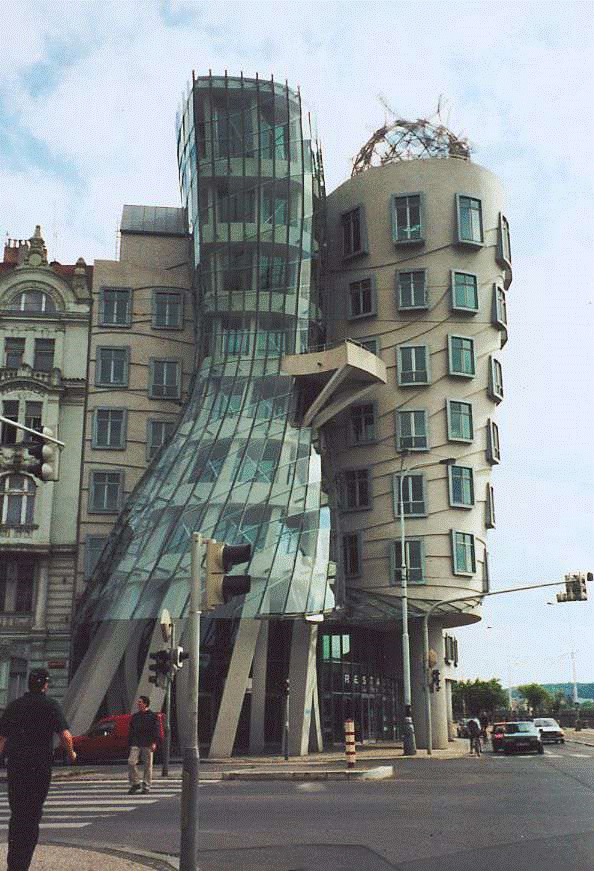Zlata Praha (Golden Prague), the city of a hundred golden
spires, is one of the prettiest cities in the world. Divided by
the Vltava (Moldau) River, Prague was fortunate not to have
suffered destruction in World War II.
a history of over 1000 years, Prague is considered the soul of
Bohemia. In 1939, the Germans
occupied Czechoslovakia. After World War II, independence
was restored but the country was soon to be dominated by the Soviet
Union.
With the 1989 election of President Vaclav Havel, Communism was
ousted in what was called the “Velvet Revolution”. At
midnight, on December 31, 1992, there was a quiet “Velvet Divorce”
ceremony in which the country separated into two national components,
the Czech Republic and Slovakia.
Lesser (or Little) Quarter (Mala Strana),
Quarter is reached by crossing the Charles Bridge that
spans the Vltava River. This bridge, built in the
13th century, is renowned for its 30 statues.
 |
|
AN
ARCH OF THE CHARLES BRIDGE |
New Town, (Nove Mesto), is the location
of Wenceslas Square which, in reality, is more of a long
boulevard than a square. It is also the location
of “Fred and Ginger” (The “Dancing House”), named after
the famous dancers Fred Astaire and Ginger
Rogers. This ultra-contemporary, swaybacked structure,
whose twirling twin towers appear to be dancing, was designed by
architect Frank Gehry.
 |
| FRED AND GINGER…FRANK GEHRY’S DANCING HOUSE |
Old Town, (Stare Mesto), beginning at Powder
Tower, has among its attractions the house where the
famed author Franz Kafka was born, the Town Hall, and its famous
15th century Astronomical Clock. The clock’s carved
figures of Death, Vanity, Greed, and the 12 Apostles put on their
ever-repeating hourly march. Here too
is Josefov, the old Jewish Quarter whose
exquisite structures document Jewish history.
 |
|
15TH CENTURY ASTRONOMICAL CLOCK IN OLD TOWN |
named after Emperor Josef II who relaxed many of the discriminating
laws against Prague’s Jewish community, was once home to more than
50,000 Jews. Today there are only 3000 registered Jews in the
entire Czech Republic, with approximately 1500 of them residing
in Prague. Yet Prague’s ancient Jewish Quarter is one of the main
tourist attractions in the city .
The Jewish Museum, that manages most of the Jewish sights
in Josefov, “is today an inspiring example of
an institution governed by conscience and memory.” Included
under the auspices of the museum are the following:
The Maisel Synagogue was built in 1590-92 and considerably
rebuilt from 1893-1905. Named after a 16th century
mayor of the ghetto, it is currently used by the Jewish Museum as
exhibition space for liturgical silver and other religious objects.
The Ceremonial Hall, adjoining the Maisel Synagogue looks like
a tiny medieval castle. It now houses a permanent
exhibition of drawings made by children who were confined in Terezin
concentration camp.
The Spanish Synagogue, built in the second half of
the 19th century on the site of Prague’s first
(11th century) synagogue, got its name from the
pseudo-Moorish style in which it was built. After
years of refurbishment, the synagogue reopened on the
130th anniversary of its founding. The Pinkas Synagogue,
founded in 1479, is the second oldest synagogue in
Prague. The interior of this touching memorial to the
Holocaust is inscribed with the names of the 77,297 Czech Jews who
were murdered by the Nazis.
The Klausen Synagogue, a Baroque structure completed in
1694, houses many exhibits including those relating to the
16th century Rabbi Low who created the legendary robot called
“Golem” out of clay. Legend has it that Golem was brought
to life by Rabbi Low who read prayers and wrote God’s name on a
piece of paper that he put in Golem’s mouth. During the
day, Golem helped the rabbi. At night, he walked the
street protecting Jews from their enemies, which he intimidated with
his size and strength.
When Rabbi Low decided to end Golem’s life because he was no longer
needed, he carried Golem to the attic of the Old-New Synagogue and
said the same prayers as before, only backwards. In the
end, only a pile of clay remained. Today, images of
the Golem are seen throughout the Jewish Quarter on everything
from postcards, to tee shirts, to works of art.
 |
| THE OLD-NEW SYNAGOGUE IN THE JEWISH QUARTER |
The Old Jewish Cemetery, founded in 1478, is the burial site of Rabbi
Low. Over 12,000 gravestones are crammed into this area where
some 100,000 people are said to be buried on top of one another in
stacks that are 10-12 bodies deep.
 |
| OLD JEWISH CEMETERY IN PRAGUE
|
The Old-New Synagogue, not under the auspices of
the Jewish Museum, is the oldest surviving synagogue
in Europe (1270) and one of the earliest Gothic buildings in Prague.
The synagogue is tucked beneath the Baroque Clock Tower of
the Jewish Town Hall. The Clock Tower has two
clocks. The first has traditional numbers; the second has
Hebrew figures. As Hebrew reads from right to left, so the
hands on the second clock turn in an anti-clockwise direction.
For a tasty meal, pass through the gates at Savarin Palace and
you will find yourself in the middle of mystical
Morocco. Here, Casablanca
Restaurant serves Middle-eastern specialties in an
authentic atmosphere. (Na Prikope 10).
Prague is a magical city that belongs on everyone’s “must-see” travel
list. Once a diamond in the rough, it has emerged as a
sparkling gem atop a velvet pillow. A pillow created by a
Velvet Revolution.
JANET STEINBERG is an award-winning Travel Writer,
International Travel Consultant, and
winner of 40 national Travel Writing Awards.

